Botany wool, often known simply as botany (though I find the ‘wool’ part helpful in differentiating it from the general ‘flowers and trees’ type of botany) is an early name for merino wool produced in the Antipodes.
(OK, so I’m not 100% sure that suit is made of Botany wool. But it might very well be. And it’s spectacular. And there are only so many images of socks I can show you).
In the 19th century it was spun into cloth and used in outer wear, and so the term ‘botany wool’ could mean the fabric, not the raw materials. In the 20th century it has mainly been used in knit sweaters and hosiery, though as late as 1922 you could still buy ‘Botany wool’ serge.
According to most dictionaries, the term arose in the 1880s, when the Australian wool industry was established enough to export in reasonable quantities. However, there are advertisements describing cloth as ‘botany’ in New Zealand at the end of the 1870s, so it may be a bit older. It was the main term used for merino wool in the Southern Hemisphere at least until WWII, after which it was gradually replaced by the term ‘merino’ (which had previously only referred to Spanish wool), though some manufacturers still describe items as being made from merino/botany wool to this day.
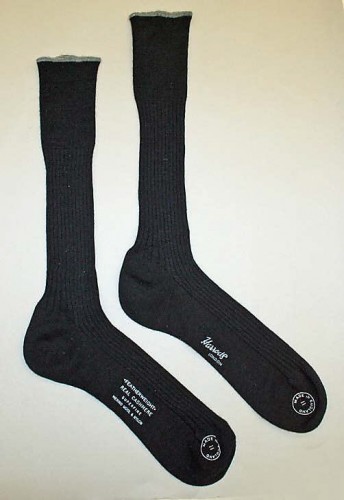
Stockings labelled ‘merino’ rather than ‘Botany wool’, Harrod’s, ca. 1960, British, merino wool, nylon, Met
Botany wool advertisements begin appearing in New Zealand newspapers (and one assumes that New Zealand would have been an obvious market) with regularity in the early 1890s.
The name comes from Botany Bay in New South Wales (so named because Captain Cook’s on-board botanist was so charmed by the plethora of flowers and trees in the area), which, like a number of locations in the Southern Hemisphere (*cough, cough, New Zealand*) produces superb merino wool. An 1886 article on the frozen mutton trade describes the origins of the term:
Good merino wool, it does not matter from whence it comes, is known as ‘Botany’ simply because the New South Wales people were the first to send Home [to England] wool of that particular description.
Sheep that produce fine, soft, merino-type wool were introduced into Australia and New Zealand at the end of the 18th century and in the first half of the 19th century, with the most notable groups being the flocks brought by the seriously awesome Eliza Furlong. At least one story claims that George III had a suit made from the first lot of Australian merino to be turned into cloth.
While the term was not indicative of where the wool came from, wool itself probably came from all over Australia (and probably, at various points, New Zealand) there actually were wool works in Botany Bay Sydney in the 19th century, and into the early 20th century. A fire destroyed the works in the 1890s, but they were rebuilt. The striking and industrial action that plagued the industrialised world in the early 20th century shut down the works on a number of occasions – in 1911, and again after WWI in 1919. The wool industry saw a slump after WWI, as prices were kept artificially high during the war, helping the industry in the short-term, but hurting it in the long-term, as the high prices encouraged people to invest in alternatives such as artificial silk (rayon).
While wool stockings don’t sound that fun, compared to other alternatives, knit merino must have been very comfortable to wear. Have you ever worn merino wool? It’s fabulous. Lovely and scrummy and soft and warm and not at all itchy. Those of you in the Northern Hemisphere where it is hard to find don’t know what you are missing!
Some Botany wool is described as “Cashmere finished”. I’m not entirely sure what this meant. Was there cashmere added? Or was it simply a brushed effect that made it feel softer? Botany wool was also blended with other fibres. In the 1890s you could buy ‘Cammelaine‘ a yarn for socks, of blended botany wool and camel hair. In the 1920s you could buy “pure botany wool llama socks” – leaving one to wonder exactly what those were made of!
Botany wool appears to have been highly regarded worldwide as a high-quality, luxury fabric, but the British governments still took steps to promote it. In 1934 Queen Elizabeth (the Queen Mother) bought “a child’s jersey and skirt suit in Botany wool, decorated with Mickey Mouse pictures” at a display of British manufactured textiles. Was it just a publicity stunt (in the best possible sense) or did Princess Elizabeth or Princess Margaret have a Disney themed frock as a child? Hard to imagine!
Update: Here is a 1960s jacket of
Sources:
O’Hara, Georgina, The Encyclopedia of Fashion: From 1840 to the 1980s. London: Thames and Hudson Ltd. 1986
Dictionary.Com “Botany Wool”.

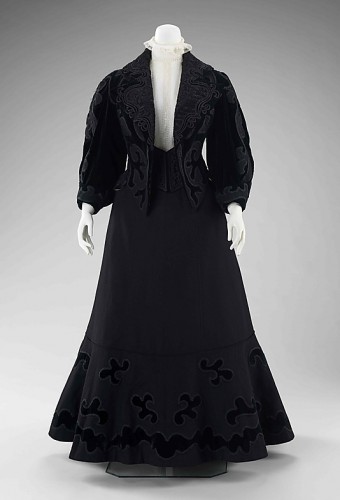
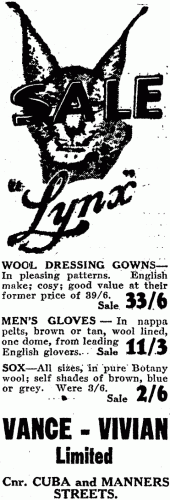
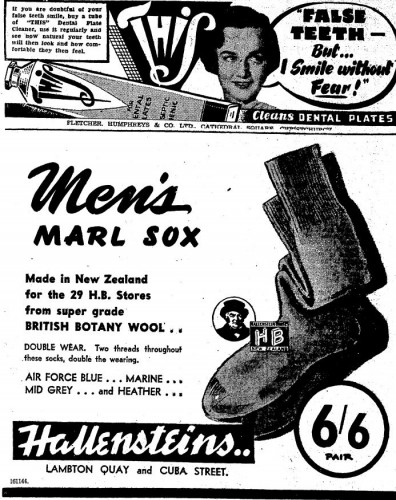
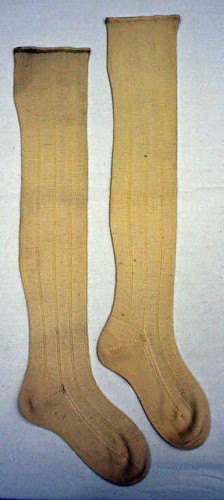
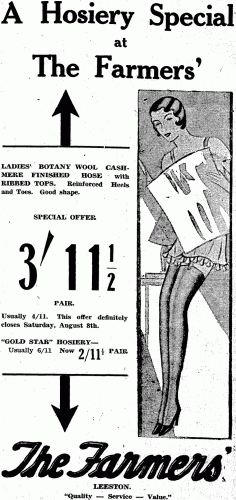



Thanks for another awesome terminology post! I get so much out of these.
Thank you! I try my best to make them interesting and enlightening.
oooOooh! Can I use the term “Botany Wool” now or is that too anachronistic? I like it. What a great terminology post about one of my favorite fibers!!!
Chinese manufacturers do, so I think you can. I only wish I can come across all this information while you were making your fantastic merino wool top!
There will be other lovely Botany Wool tops and so forth in my future. Depend on it… 😉
I noticed this term in the advertisements you put on Facebook the other day. First time I’d seen it to my recollection. Thank you! Most interesting.
With regard to the ‘cashmere finish’, I would back the idea of the brushed finish. I bought a wonderful pair of vintage-but-new cotton sheets on Trade Me that had what they described as a ‘linen finish’. No linen involved, but certainly with that wonderful soft feel that linen can have. They would have dated from the 1950s, I would guess. Made in Scotland, and been lurking in someone’s Hope Chest/Glory Box/Bottom Drawer.
By the way, I find merino wool to be a little itchy. The only wool I don’t find to be itchy at all is good-quality cashmere.
Thanks for posting this. It was interesting; I had never heard the term “botany wool” used before.
Merino wool is itchier than cashmere, but, like cashmere, it varies in quality, so the best stuff is quite non-itchy.
I love these terminology posts! It’s also very interesting for me as a learner of English. 🙂
And it leaves me wondering what my winter coat is made of. It says only “100% wool” (in Czech), but it’s very soft to the touch and not itchy at all (when I rub it carefully, I can sort of feel that it could be itchy, but it’s simply not). I googled the brand this week and it turns out it was made by a small firm (if not even singular seamstress) in a Moravian village. I got it on a clothes exchange, so I have no idea where exactly it came from… anyway, it leaves me wondering what kind of fabric that seamstress used!
Fascinating post, but I must admit to being totally distracted by the advert for denture fixative in one of the pictures. “False teeth – but I smile without fear”, is just such a wonderful slogan!
Isn’t it fantastic? The interesting thing is that there is an ad on TV right now about “do your dentures make you afraid to smile?” We really haven’t progressed much!
Merino wool is perfectly widely available in the Northern Hemisphere (US at least), although it’s a bit expensive. I’m not really sure whether it’s more expensive than other wools or not, as wool is in general several times more expensive than cottons in the US. Merino is very popular with hobby luxury knitters in particular, but you’ll always see sweaters and scarves labeled merino in higher-end sellers of such things.
On another note, Catherine might have a slight allergy to sheep wool which makes even Merino seem a bit itchy. Cashmere is properly goat wool, so wouldn’t necessarily apply. This was the case with the husband of a knitting acquaintance of mine. After she became frustrated that he reported the most baby-soft things she’d made as a gift for him out of expensive yarn to be scratchy, his mother unrelatedly mentioned that they found that he as a child had a sheep wool allergy. I’m a fan of alpaca myself.
I’ve just bought a Botony wool black cardigan from a second hand shop for £3.50. It has an old Marks and Spencers label on and is hardly worn. So I think I’ve got a bargain. It is a very fine knit and just right for under coats without the bulk.
You must let the non-Kiwis know all about the amazingness that is Merino-Possum blended knits. It’s snuggletastic.
I would, but I don’t actually like it! It feels weird and scratchy to me – I much prefer pure merino. No idea why, as most people find it the most amazing stuff.